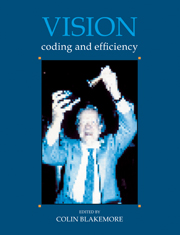Book contents
- Frontmatter
- Contents
- List of Contributors
- Preface
- Reply
- Acknowledgements
- Concepts of coding and efficiency
- Efficiency of the visual pathway
- 5 The design of compound eyes
- 6 The light response of photoreceptors
- 7 Is there more than meets the eye?
- 8 Quantum efficiency and performance of retinal ganglion cells
- 9 Neural interactions underlying direction-selectivity in the rabbit retina
- 10 Detection and discrimination mechanisms in the striate cortex of the Old-World monkey
- Colour
- Brightness, adaptation and contrast
- Development of vision
- Depth and texture
- Motion
- From image to object
- Index
5 - The design of compound eyes
Published online by Cambridge University Press: 05 May 2010
- Frontmatter
- Contents
- List of Contributors
- Preface
- Reply
- Acknowledgements
- Concepts of coding and efficiency
- Efficiency of the visual pathway
- 5 The design of compound eyes
- 6 The light response of photoreceptors
- 7 Is there more than meets the eye?
- 8 Quantum efficiency and performance of retinal ganglion cells
- 9 Neural interactions underlying direction-selectivity in the rabbit retina
- 10 Detection and discrimination mechanisms in the striate cortex of the Old-World monkey
- Colour
- Brightness, adaptation and contrast
- Development of vision
- Depth and texture
- Motion
- From image to object
- Index
Summary
Introduction
In 1952, Barlow wrote a paper in which he spelled out the implications of the diffraction limit for compound eyes, where the small size of each lens makes diffraction a much more severe problem than it is in eyes like our own with a single large lens. This paper, modestly entitled ‘The size of ommatidia in apposition eyes’, contained a sentence which seemed to me when I first read it as a graduate student wonderfully immodest. He wrote, ‘Imagine the problems concerned in designing an eye for an insect’, and then went on to work out the relation between the resolution of a compound eye and its size, and the size of its component parts. People in those days rarely thought like that; it was one thing to try to sort out an organ's function, but quite another to set about its design. A generation before genetic engineering made such ideas almost commonplace, Barlow's assertion that one could understand natural structures at that kind of level seemed exciting and pleasingly impious.
It is because we understand the behaviour of light so well that it is possible to entertain such ideas about eyes. For livers and kidneys, or even ears and noses, no correspondingly exact body of knowledge exists to permit a thorough analysis of the physical constraints on their design. Thus it is possible to attribute function to structure with more precision in the eye than in any other sense organ; and to a comparative physiologist one of the beauties of studying eyes is the confidence one has that differences between eyes are important. As Gordon Walls put it, ‘everything in the vertebrate eye means something’ (Walls, 1942).
- Type
- Chapter
- Information
- VisionCoding and Efficiency, pp. 55 - 64Publisher: Cambridge University PressPrint publication year: 1991
- 33
- Cited by



